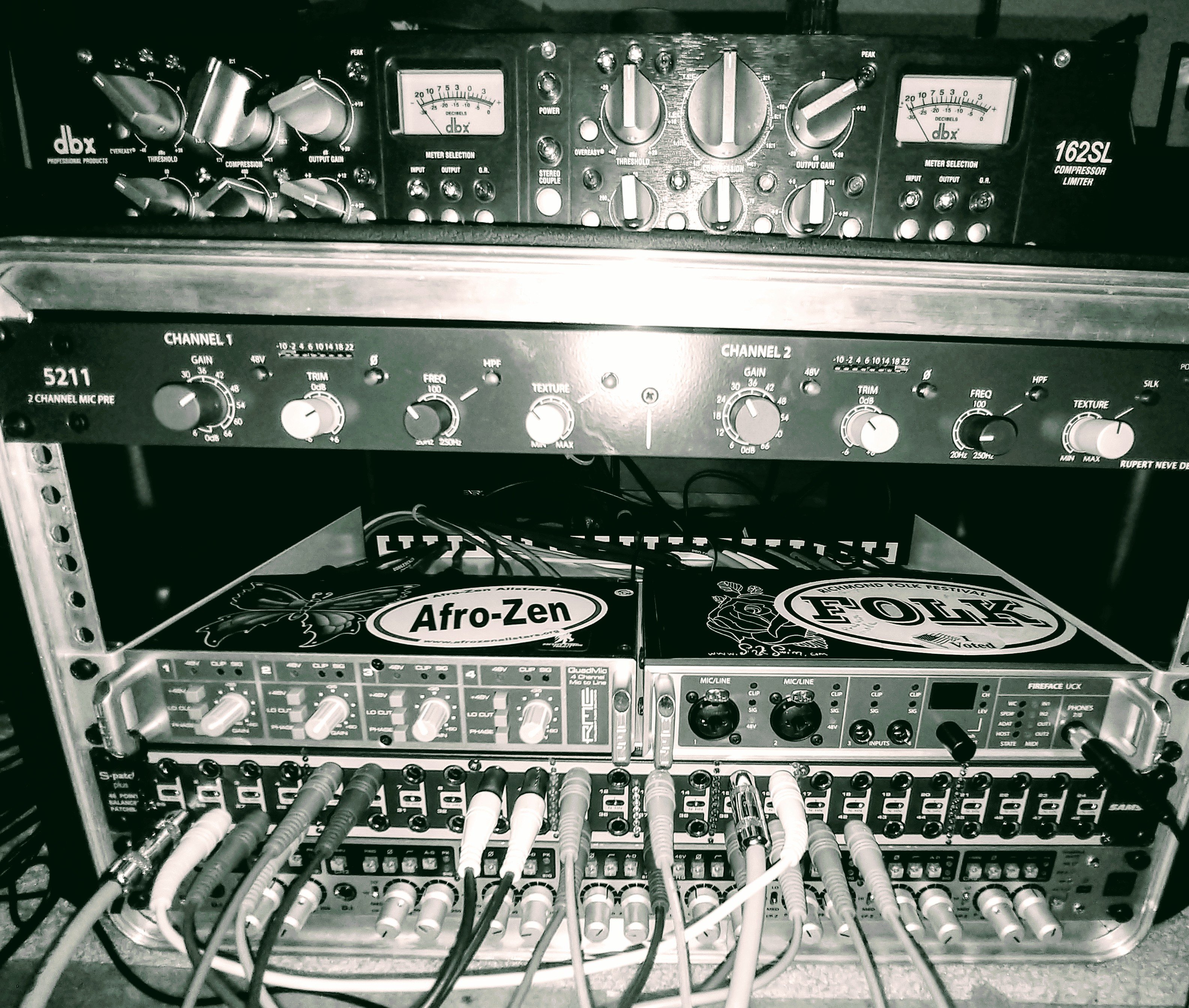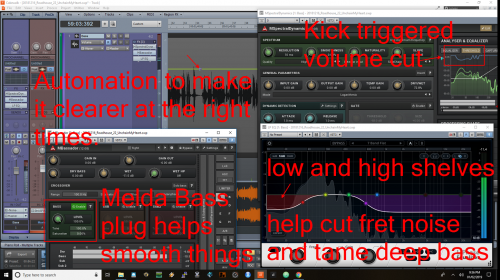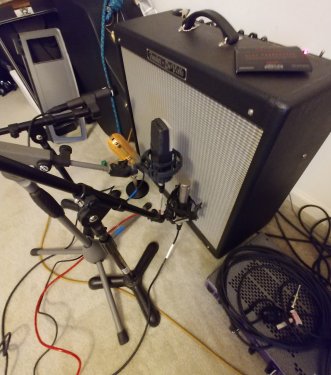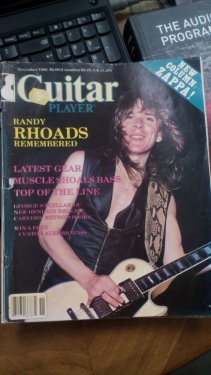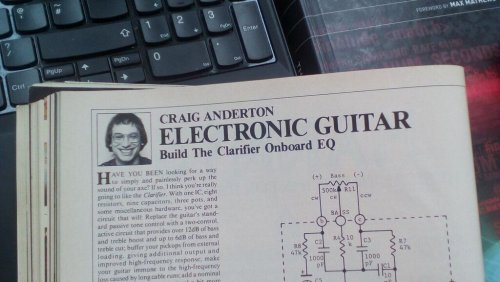-
Posts
1,486 -
Joined
-
Last visited
-
Days Won
1
Everything posted by Gswitz
-
Try hitting E to bypass all FX before opening the synth. See if that helps. There may be another plugin that doesn't like the audio stuff that happens as the synth pops open.
-
I struggle with bass more than any other instrument. I like to be able to hear it properly. On my most recent project I didn't blend direct and mic'd bass. I just used the mic'd bass track. Attached is an image of the fx I'm using with some text as to why. The recordings are here in case you want to listen to see if you like how it came out http://gswitz.blob.core.windows.net/tunes/20181216_Roadhouse.html At the bottom of Scook's link are some cheat sheets you might find helpful. Part of your problem may be that you don't play a ton of bass. Try finding a bass player to help you some. The fx are mspectraldynamics sidechained with the kick drum. You could use any sidechainable compressor for this... Melda MBassador. This is a little bit of saturation, I think. If you don't own the plug, try some tube saturation. LP EQ >> Cakewalk.
-
Works fine for me. I use my FCB1010 with TH3. But TH3 can't be in the Pro Channel for some reason. It has to be in the FX Bin. I can change patches or enable and disable pedals. Use expression. Start and stop the looper etc. All with my feet.
-
It was interesting. I don't tend to record multi-track drums separate from the band, but I can see why you would and why you would want to tighten them up.
-
@Steev You mention doing large multitrack live recordings with sonar/cakewalk. I want to speak to that. On a power failure or abrupt shutdown, sonar will lose all unsaved data, last time I checked. On a drop-out case, sonar stops recording and doesn't resume. Until you notice, you are losing tape. Rme digicheck is what I use for live recordings. In my tests, you can pop the battery out of an unplugged laptop while recording and not lose more than a couple of seconds of tape. It's magic. Additionally, when digicheck loses a buffer, all tracks miss exactly that buffer and keep recording. There is a warning. This means that if you do something stupid to cause a brief interruption, you don't lose more than you must. On the plus side, sonar/cakewalk has the nice wave forms that help you get your levels set properly. I like that you can scale them up four easy reading.
-
Also remember Linux Ubuntu studio. This is a free low latency build. I have used it on a USB ssd to make 16 track recordings.
-
Yes. ????? It's ok. I use it sometimes and i have used it for live field recordings successfully. That said, I can go months without launching it.
-
Me too. I'm using melda.
-
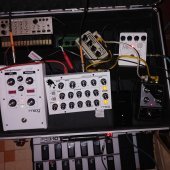
Is It Helpful to Have Separate General and Q&A Forums?
Gswitz replied to henkejs's topic in Cakewalk by BandLab
I've only been reading general. This thread brought my attention to the other spot. ? Makes no difference to me. -

Recording Clean Electric Guitar, Two hand tapping?
Gswitz replied to sadicus's topic in Cakewalk by BandLab
When you go to the top of the Pro Channel and click the open folder icon, you get a long list of guitar pro-channel configurations you can try. -
Thanks for the wall tip. My house isn't very big and pulling it out will block a foot passage so I can't leave it there all the time, but I can definitely pull it out for a re-amping session or such.
-
Craig, I've spent time with TH3 trying to mimic the sound where I record the amp directly. This video shows me trying to get a sound from TH3 that was close to the sound in my room. In that one, I positioned the mics on the same cone in the same position more or less every time. I had a recording of the guitar bit and re-amped it switching mics then tried to match the sounds in TH3. I soldered myself one of these... https://www.diyrecordingequipment.com/products/l2a. On another session, after getting a Rivera Rock Crusher, I was curious if I could use only TH3 Cabs and Mics to get a sound like I get from my amp. I was not super happy. I took the direct line our of the Rivera (so between the amp and the speaks) and also recorded my amp. I then tried in TH3 to just add a cab and mics to get something similar. It really was not as good, but less noticeable than the effort I made with all the hardware. So, a sacrifice, but not much of one. I can totally use it for late night headphone jams. Good enough for what I do. I had been interested in a Universal Audio OX Reactive Amp Attenuator, but bought the Rock Crusher because it was soooo much less expensive. I figured I could add my own cab sim and tried the sounds. I'm thinking playing more guitar myself where I reamp on a Saturday and spend a few hours changing mics and trying sounds is probably smart. As you say, Go ahead!! You won't break anything!! ? Last night, I came to realize that having the amp up loud definitely makes the SM57 sound much better. Recording at a low level it sounds much less tasty than my other mics. The video in this post was recorded with the amp at 2.5 or so, and that was too low to really get a good sound on some of the mics, probably. Also, I don't think that TH3 does a great job of emulating the amps at low volume. I think it's really focused on the top half of the volume range, not the bottom.
-
I probably just need more practice.
-
The only bug that had tripped me lately is around normalizing.
-
I love to record loud guitars. I hate it when I don't love the recording when I get home. This happened to me recently and so I took some time to check out my mics and record them at home. I think I'm asking for help. I feel foolish being unsure at this late stage of my recording experience. When recording a loud guitar (or 2), there is no way to listen to the recording while the band performs. You just have to wait until later. I often just mention mic choices to the guitarist and let his/her random answer guide the choice. When I mic the toms, kick, snare and 2 overheads, I don't usually have room for more than one mic per guitar. I'm starting to think this is a mistake. I should really be recording guitars with 2 mics per cab just to increase the chance of a great recording. I really don't like to record more than 16 channels at a time. It's a pain to go above that. Anyway, I made a video with some sounds I captured at home. Listening, it occurred to me that a ribbon tilted up at the speaker in a rugged room does kill some of the sound that would come in to it from behind. It makes it warmer to be lower on the amp and crisper to be higher. I feel like I don't get enough practice at this to become good at it. ?
-
Ah but the midi is stored in the .cwp file. Audio files are stored in an Audio folder. I believe the envelopes and other timely settings are basically midi data as well. so if you draw sign envelopes you quickly increase the size of your cwp because of all the points. Likewise if you record the midi for your guitar 500 times as you practice a piece, you get a large file. ? Who would do that?? So the auto save becomes a hassle in some cases but not most for me.
-
The video is awesome and it makes me want to quit my day job. In January 2018, I took an online class (Andreas Oberg with Artist Works - Jazz Guitar) where I wanted to learn what the teacher played. I made a video of how I extracted what he played and then when I played it, I could see my midi notes and how they compared to his. It starts around 3 minutes in. My midi on my guitar doesn't pick up the slides very well, but you get the idea. ** I'm mentioning this because in the other MIT video it talked about real-time feedback on a cello performance. **
-
I have sonar keep intervals of projects so even if I forget to save I can go back. Preferences > File > Advanced > Auto-save every 15 minutes. Enable versioning, keep 10. This would have made it possible for you to go back. For files with lots of midi, this becomes a pain because the saves are slow. I disable this feature when working with large midi files so that the saves do not become intrusive. For regular mixing, I never notice it and have the backups whenever I need them. They are tiny compared to the projects as a whole.
-
Ah yes. That's true. I understand. I wasn't designing the cross-over. More I was realizing that the cross-over frequency is like a shelf frequency and the cross-over gain like a shelf-gain for listening purposes. In other words, the sub with the volume knob and sweepable frequency for the cross-over ends up behaving like a shelf for the listener. Obviously the sound comes from a different place. I remember being taught that it didn't matter where the sub is because you can't tell where bass comes from. That is entirely wrong imho. Why do people say that?
-

[ SOLVED ] Guitar Tuner not displaying correct notes
Gswitz replied to sadicus's topic in Cakewalk by BandLab
Mine auto changes to the correct Hz matching the project unless some other application (like another Daw) has it locked to a different rate. -
The shelf can raise or lower the gain of the shelf. I thought the word shelf just mean that it was a flat line that ran from some point to the end of the audible spectrum (or that carried by the hardware). My sub does have a knob for adjusting the cross-over point and another for the gain. The speaker cables leave the sub and go to the speaks after the cross-over. I'm not sure why a sub would be a HPF. Perhaps what is sent to the speaks is high-passed and what is carried by the sub is low-passed, but to me this is the definition of using a cross-over.
-
-
It occurs to me that a sub with a crossover is really a low shelf with a fixed q, adjustable frequency and gain. Am I thinking of this correctly?

